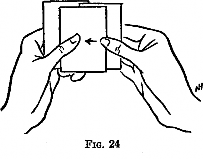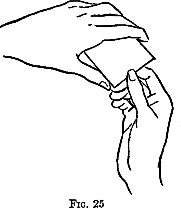
7. THE FALSE COUNT

1st Method. To make it appear that you have more cards than you really hold. For example, you have seven cards and it is necessary to count them as eight cards. Hold the seven cards in the left hand vertically, face outwards, the thumb on the middle of the back pressing the packet against the inside of the first three fingers, the left little finger curled against the bottom. Push off the top card and take it in the right hand between the tips of the thumb and the first and second fingers. Count “One.” Push off a second card with the left thumb and take it in the right hand in front of the first card. Count “Two.” Push off a third card and, at the moment the hands meet, with the right thumb push the first card to the left (Fig. 24); with the left thumb pull it flush with the packet, while the right hand carries away the third card. Count “Three.” Then finish the count, one card at a time; one card having been counted twice, the final count will be “Eight.”
Two or three cards can be pushed back in the same way, increasing the count accordingly; It is essential that the cards be taken off by the right hand in perfect rhythm.

2d Method. To make the count less than it should be. Hold the cards face down in the left hand, in position for the glide, and draw back the bottom card. We will suppose you have nine cards and it is necessary to count them as six. With the right thumb draw off the top card against the right fingers (Fig. 25). Count “One.” Pull off the next card on top of the first one.
Count “Two.” Do the same for “Three” and “Four”; but at “Five” take all the cards above the drawn back card as one card, snap the remaining card in the left hand with the left thumb and finger, and count “Six.”
Here again the count must be made in the same tempo throughout, and the outer end of the left-hand packet should point downwards so that the spectators cannot form any estimate of how many cards it contains.
Website Content: © Copyright 2024 by Trickshop.com.